Argan oil is produced from the fruits of the Argan tree which grows nowhere in the world except in southwestern Morocco. It is believed to date back 25,000,000 years and to have once covered N. Africa wild in semi-desert soil, its deep root system helping to protect against soil erosion.
It was first reported by the explorer Leo Africanus in 1510. Now only 860,000 hectares remain in S.W. Morocco and these are declining at a rate of 50,000h per year. Measures are being put in place to protect this rare and endangered species and in 1999 the argan was listed as a UNESCO Biosphere Heritage.

Originally uploaded by Julie70
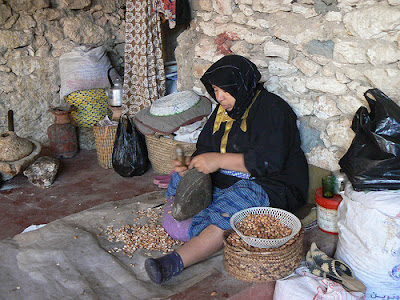
Originally uploaded by dianjo
The most labour intensive part of oil-extraction is removal of the soft pulp (used as animal feed) and the cracking by hand, between two stones, of the hard nut. The seeds are then removed and gently roasted.
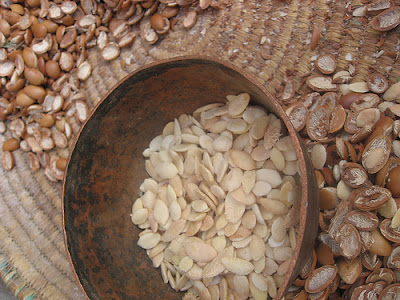
Originally uploaded by carolynalicedaly
This roasting accounts for part of the oil's distinctive, nutty flavour. The traditional technique for oil extraction is to grind the roasted seeds to paste, with a little water, in a stone rotary quern. The paste is then squeezed between hands to extract the oil.
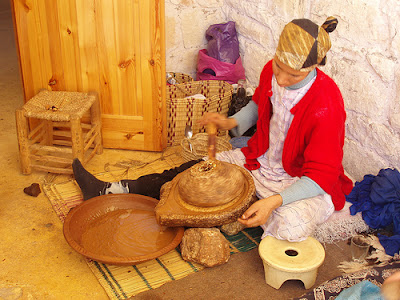
Originally uploaded by AcedulineThe extracted paste is still oil-rich and is used as animal feed. Oil produced by this method will keep 3-6 months, and will be produced as needed in a family, from a store of the kernels, which will keep for 20 years unopened.
Dry-pressing is now increasingly important for oil produced for sale, as the oil will keep 12-18 months and extraction is much faster.

Originally uploaded by easyondeuxize
Goats like the pulp of argan fruits and often try to climb the trees to get at them. They will digest the pulp, but shed the undigested seeds in their feces.
As these have shells that are somewhat softened and easier to crack, they are occasionally used to produce oil for non-culinary purposes. An urban legend has it that all argan oil is produced this way. This myth seems to be based on the fact that occasionally, shrewd traders would have sold (and may still try to sell) such "non-food grade" argan oil to ignorant travellers or tourists.

Originally uploaded by Maria McCann!
The fact that the nuts acquire a foul aroma in passing through the animal's digestive tract makes it easy to tell this oil apart from food-grade produce with its rich, walnut oil-like flavor.
It was first reported by the explorer Leo Africanus in 1510. Now only 860,000 hectares remain in S.W. Morocco and these are declining at a rate of 50,000h per year. Measures are being put in place to protect this rare and endangered species and in 1999 the argan was listed as a UNESCO Biosphere Heritage.

Originally uploaded by Julie70

Originally uploaded by dianjo
The most labour intensive part of oil-extraction is removal of the soft pulp (used as animal feed) and the cracking by hand, between two stones, of the hard nut. The seeds are then removed and gently roasted.

Originally uploaded by carolynalicedaly
This roasting accounts for part of the oil's distinctive, nutty flavour. The traditional technique for oil extraction is to grind the roasted seeds to paste, with a little water, in a stone rotary quern. The paste is then squeezed between hands to extract the oil.

Originally uploaded by Aceduline
Dry-pressing is now increasingly important for oil produced for sale, as the oil will keep 12-18 months and extraction is much faster.

Originally uploaded by easyondeuxize
Goats like the pulp of argan fruits and often try to climb the trees to get at them. They will digest the pulp, but shed the undigested seeds in their feces.
As these have shells that are somewhat softened and easier to crack, they are occasionally used to produce oil for non-culinary purposes. An urban legend has it that all argan oil is produced this way. This myth seems to be based on the fact that occasionally, shrewd traders would have sold (and may still try to sell) such "non-food grade" argan oil to ignorant travellers or tourists.

Originally uploaded by Maria McCann!
The fact that the nuts acquire a foul aroma in passing through the animal's digestive tract makes it easy to tell this oil apart from food-grade produce with its rich, walnut oil-like flavor.





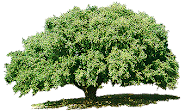




 21:15
21:15
 huile d'argane agadir
huile d'argane agadir

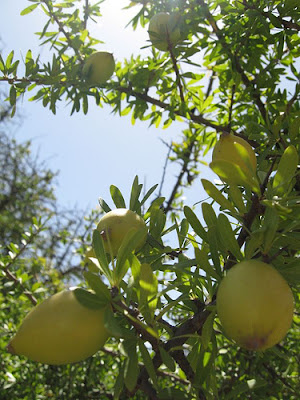




2 comments: